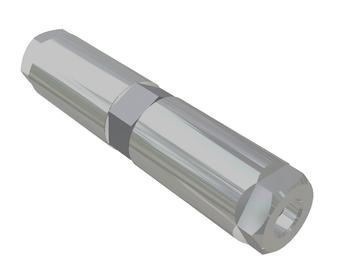precast123
Structural
Hello everyone
I have designed a coupler to join 2 prestressing strands to avoid wastage ( see attachment )
1. For 9.3 mm dia strand
a. Load Capacity = 100kN ( strand A= 52mm2, fpu = 1770 N/mm2, 70% tensioning only)
b. Base thickness of plate = 15mm (limited to 15mm to maintain strand cover)
c. wall thickness = 20mm
d. Plate S355 with min yield strength = 355 N/mm2
e. Fillet weld on both sides all around with strength 390 N/mm2 (SG2)
f. From SAP2000 model, max stresses are in range of 190N/mm2
2. For 12.7 mm dia strand ( strand A= 97 mm2, fpu = 1770 N/mm2, 70% tensioning only)
a. Load Capacity = 200kN
b. Base thickness of plate = 15mm (limited to 15mm to maintain strand cover)
c. side wall thickness = 20mm and front wall where the barrel will fix = 30mm
d. Plate S355 with min yield strength = 355 N/mm2
e. Fillet weld on both sides all around with strength 390 N/mm2 (SG2)
f. From SAP2000 model, max stresses are in range of 190N/mm2
My questions are:
1. Did I choose the correct plate for this purpose? Any suggestions? which plate can perform better in welding ect
2. Which rod to choose for welding the plate?
3. Are the stresses in plate and weld are OK?
4. Will this coupler system will work or i am missing something?
I have designed a coupler to join 2 prestressing strands to avoid wastage ( see attachment )
1. For 9.3 mm dia strand
a. Load Capacity = 100kN ( strand A= 52mm2, fpu = 1770 N/mm2, 70% tensioning only)
b. Base thickness of plate = 15mm (limited to 15mm to maintain strand cover)
c. wall thickness = 20mm
d. Plate S355 with min yield strength = 355 N/mm2
e. Fillet weld on both sides all around with strength 390 N/mm2 (SG2)
f. From SAP2000 model, max stresses are in range of 190N/mm2
2. For 12.7 mm dia strand ( strand A= 97 mm2, fpu = 1770 N/mm2, 70% tensioning only)
a. Load Capacity = 200kN
b. Base thickness of plate = 15mm (limited to 15mm to maintain strand cover)
c. side wall thickness = 20mm and front wall where the barrel will fix = 30mm
d. Plate S355 with min yield strength = 355 N/mm2
e. Fillet weld on both sides all around with strength 390 N/mm2 (SG2)
f. From SAP2000 model, max stresses are in range of 190N/mm2
My questions are:
1. Did I choose the correct plate for this purpose? Any suggestions? which plate can perform better in welding ect
2. Which rod to choose for welding the plate?
3. Are the stresses in plate and weld are OK?
4. Will this coupler system will work or i am missing something?

